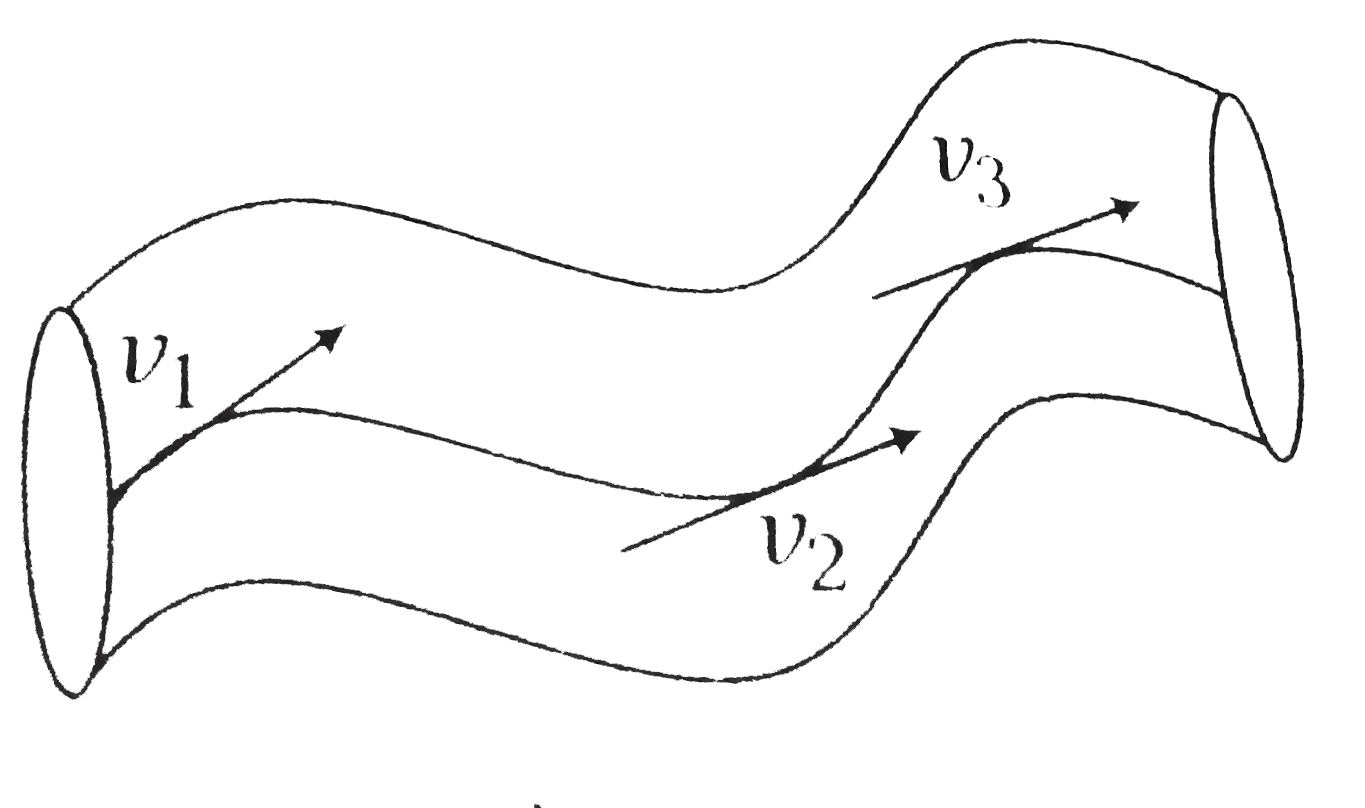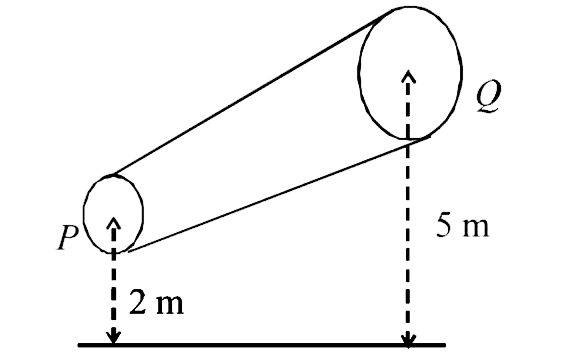In a streamline flow
the speed of a particle always remains same
the velocity of a particle always remains same
the kinetic energies of all particles arriving at a given point are the same
the potential eneergies of all the particles arriving at a given point are the same
The correct Answer is:C
To solve the question regarding streamline flow, we will analyze the properties of the flow and evaluate the given options step by step.
1. Understanding Streamline Flow:
- Streamline flow refers to a type of fluid flow where the fluid moves in parallel layers with no disruption between them. The path followed by the fluid particles is called a streamline.
- In streamline flow, the velocity of the fluid particles at any point is constant over time, but it can vary from point to point.
Hint: Remember that streamline flow is characterized by smooth, continuous paths of fluid particles.
2. Analyzing the Options:
- Option 1: "The speed of a particle always remains the same."
- This is incorrect because while the speed can be constant along a streamline, it can vary from one streamline to another.
Hint: Consider that speed can change from one point to another in a fluid.
- Option 2: "The velocity of the particle always remains the same."
- This is also incorrect. Velocity is a vector quantity that includes both speed and direction. While the speed may be constant along a streamline, the direction can change, leading to a change in velocity.
Hint: Recall that velocity depends on both speed and direction.
- Option 3: "The kinetic energies of all particles arriving at a given point are the same."
- This is correct. In a streamline flow, the kinetic energy of fluid particles can be considered equal at a given point if they are at the same height and moving along the same streamline.
Hint: Kinetic energy depends on speed, and for particles at the same point in a streamline flow, their speeds can be considered equal.
- Option 4: "The potential energies of all particles arriving at a given point are the same."
- This is not necessarily true. The potential energy can vary based on the height of the particles in a gravitational field or other factors affecting potential energy.
Hint: Potential energy can change based on the position of the particles in the field.
3. Conclusion:
- After evaluating all the options, the correct answer is Option 3: "The kinetic energies of all particles arriving at a given point are the same."
Summary:
In streamline flow, the kinetic energy of fluid particles arriving at a given point can be considered the same due to the nature of the flow, while other properties such as speed and potential energy can vary.
- Streamline flow refers to a type of fluid flow where the fluid moves in parallel layers with no disruption between them. The path followed by the fluid particles is called a streamline.
- In streamline flow, the velocity of the fluid particles at any point is constant over time, but it can vary from point to point.
- Option 1: "The speed of a particle always remains the same."
- This is incorrect because while the speed can be constant along a streamline, it can vary from one streamline to another.
Hint: Consider that speed can change from one point to another in a fluid.
- This is also incorrect. Velocity is a vector quantity that includes both speed and direction. While the speed may be constant along a streamline, the direction can change, leading to a change in velocity.
Hint: Recall that velocity depends on both speed and direction.
- This is correct. In a streamline flow, the kinetic energy of fluid particles can be considered equal at a given point if they are at the same height and moving along the same streamline.
Hint: Kinetic energy depends on speed, and for particles at the same point in a streamline flow, their speeds can be considered equal.
- This is not necessarily true. The potential energy can vary based on the height of the particles in a gravitational field or other factors affecting potential energy.
Hint: Potential energy can change based on the position of the particles in the field.
- After evaluating all the options, the correct answer is Option 3: "The kinetic energies of all particles arriving at a given point are the same."
In streamline flow, the kinetic energy of fluid particles arriving at a given point can be considered the same due to the nature of the flow, while other properties such as speed and potential energy can vary.
Topper's Solved these Questions
- FLUID MECHANICSBOOK - DC PANDEY ENGLISHCHAPTER - FLUID MECHANICSEXERCISE - B) Medical entrance special format question
19 Videos
- FLUID MECHANICSBOOK - DC PANDEY ENGLISHCHAPTER - FLUID MECHANICSEXERCISE - Match the columns
6 Videos
- FLUID MECHANICSBOOK - DC PANDEY ENGLISHCHAPTER - FLUID MECHANICSEXERCISE - Check point 13.4
10 Videos
- EXPERIMENTSBOOK - DC PANDEY ENGLISHCHAPTER - EXPERIMENTSEXERCISE - Subjective
15 Videos
- GENERAL PHYSICSBOOK - DC PANDEY ENGLISHCHAPTER - GENERAL PHYSICSEXERCISE - INTEGER_TYPE
2 Videos
Similar Questions
Which of the following diagrams does not represent a streamline flow?
View SolutionThree capillaries of length L,L2andL3 are connected in a series. Their radii are r,r2andr3 respectively. If a streamlined flow is to be maintained and pressure difference across the first capillary is ρ, then the pressure difference across the second capillary will be
View Solution
Knowledge Check
Which of the following diagrams does not represent a streamline flow?
A B
B C
C D
D
IN a streamine flow
View SolutionDistinguish between streamline flow and turbulent flow.
View SolutionFor a stream line flow of water following statements are given below
(a) Two streamlines do not intersect each other.
(b) streamlines must be straight.
(c) streamlines flow is more likely for liquids with low density and height viscosity.
(d) streamlines flow is more likely for liquids with high density and low viscosity.
View SolutionAn ideal fluid is flowing in a pipe in streamline flow. Pipe has maximum and minimum diameter of 6.4 cm and 4.8 cm respectively. Find out the ratio of minimum to maximum velocity.
View SolutionAn ideal fluid is flowing in a pipe in streamline flow. Pipe has maximum and minimum diameter of 6.4 cm and 4.8 cm respectively. Find out the ratio of minimum to maximum velocity.
View SolutionConsider streamline flow of a liquid flowing through a tube as shown in the figure which of the following is correct regarding velcities of liquid at different points ?

View SolutionA non-viscous liquid of constant density 1000kg/m3 flows in a streamline motion along a tube of variable cross section. The tube is kept inclined in the vertical plane as shown in Figure. The area of cross section of the tube two point P and Q at heights of 2 metres and 5 metres are respectively 4×10−3m2 and 8×10−3m2. The velocity of the liquid at point P is 1m/s. Find the work done per unit volume by the pressure and the gravity forces as the fluid flows from point P to Q.

View Solution
